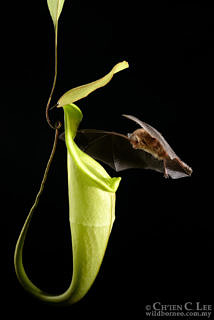Carnivorous plants attract bats with echo reflectors

An international team of researchers from Friedrich-Alexander-Universität Erlangen-Nürnberg (FAU), the University of Greifswald, and Universiti Brunei Drussalam has discovered that Nepenthes hemsleyana – a pitcher plant found in Borneo – uses an echo reflector to attract bats. However, it is not the bats themselves that the plants are after, but their droppings. As the pitcher plants grow in soil that is low in nutrients they need additional fertiliser and the bats’ droppings provide them with vital nutrients. In return, the plants offer the bats the perfect place to sleep inside their pitchers. The results of the researchers’ study have recently been published in the journal Current Biology (DOI 10.1016/j.cub.2015.05.054)*.
The Hardwicke’s woolly bats (Kerivoula hardwickii) on the island of Borneo in South-East Asia have found a unique place to roost: they spend the day inside the pitchers of a carnivorous plant of the Nepenthes genus. The bats are not consumed by the plants but find a safe place to roost inside their pitchers. Earlier studies by researchers at the University of Greifswald have shown that the pitcher plants receive nutrients from the bat droppings left behind in their pitchers – like a kind of rent. The question remained as to how the bats managed to find the rare and inconspicuous pitcher plants in the extremely dense vegetation of Borneo’s swamp forests.
It was this question that the team behind the current study was able to answer. As the Hardwicke’s woolly bats, like all bats, orientate themselves acoustically using echolocation, the researchers suspected that they also used acoustic signals to find and choose the pitchers. During several research visits to Brunei and Malaysia, in collaboration with Dr. Ralph Simon at FAU’s Chair of Sensor Technology and the team led by Prof. UImar Grafe at Universiti Brunei Drussalam, the researchers in the working group for applied zoology and conservation at the University of Greifswald, led by Michael Schöner and Caroline Schöner, set out to investigate their hypothesis.
The researchers used an artificial bat’s head to examine the acoustics of the pitchers. The artificial bat’s head was specially made at FAU and has been used successfully in the past for similar experiments. It consists of a loudspeaker that can play ultrasonic signals similar to those produced by bats and highly sensitive ultrasonic microphones that can pick up even the quietest of echoes.
The results showed that the pitchers of Nepenthes hemsleyana have a kind of corner reflector on the back wall which strongly reflects the bats’ ultrasonic calls. This structure is not found in the closest related plant species or any of the other pitcher plant species that grow in the same area as Nepenthes hemsleyana but do not benefit from the bats. ‘We have already found similar structures in plants in Central America that are fertilised by bats,’ explains FAU researcher Ralph Simon. ‘It amazed us that this kind of reflector that helps attract bats has also developed independently in Asia.’
‘We therefore wanted to find out whether this sound reflecting structure is important for bats to be able to identify the pitchers and choose them as their roost,’ Caroline Schöner adds. For their study the researchers carried out a range of behavioural experiments to investigate the effectiveness of the sound reflector. When the bats were offered pitchers in which the sound reflectors had been changed, they did not choose them as a place to roost. However, when the sound reflectors were intact they found the pitchers more quickly and also chose them as a place to roost. Changes to other aspects of the pitchers’ structure, on the other hand, had no effect on the bats’ behaviour towards the pitchers. This led the researchers to conclude that the reflector is a key feature of Nepenthes hemsleyana that allows it to be identified. It enables the plant to make bats aware of their pitchers, shows that they are a suitable roost, and even functions as a kind of signpost for the bats, allowing them to find the entrance quickly.
The study demonstrates one of the unusual solutions that organisms develop in the context of symbiotic relationships. This does not just apply to finding the required partner, but covers all aspects of this kind of interaction. ‘At the moment we are not even close to understanding the significance of symbiotic relationships for ecological balance,’ explains Michael Schöner. ‘Unfortunately many natural habitats like the swamp forests of Borneo are disappearing faster than we can discover and study the fascinating biological systems within them.’
The study was financed by the German Research Foundation (DFG), the German Academic Exchange Service (DAAD), Universiti Brunei Drussalam, the University of Greifswald, and FAU.
Further information:
Dr. Ralph Simon
Phone: +49 9131 8523359
ralph.simon@fau.de